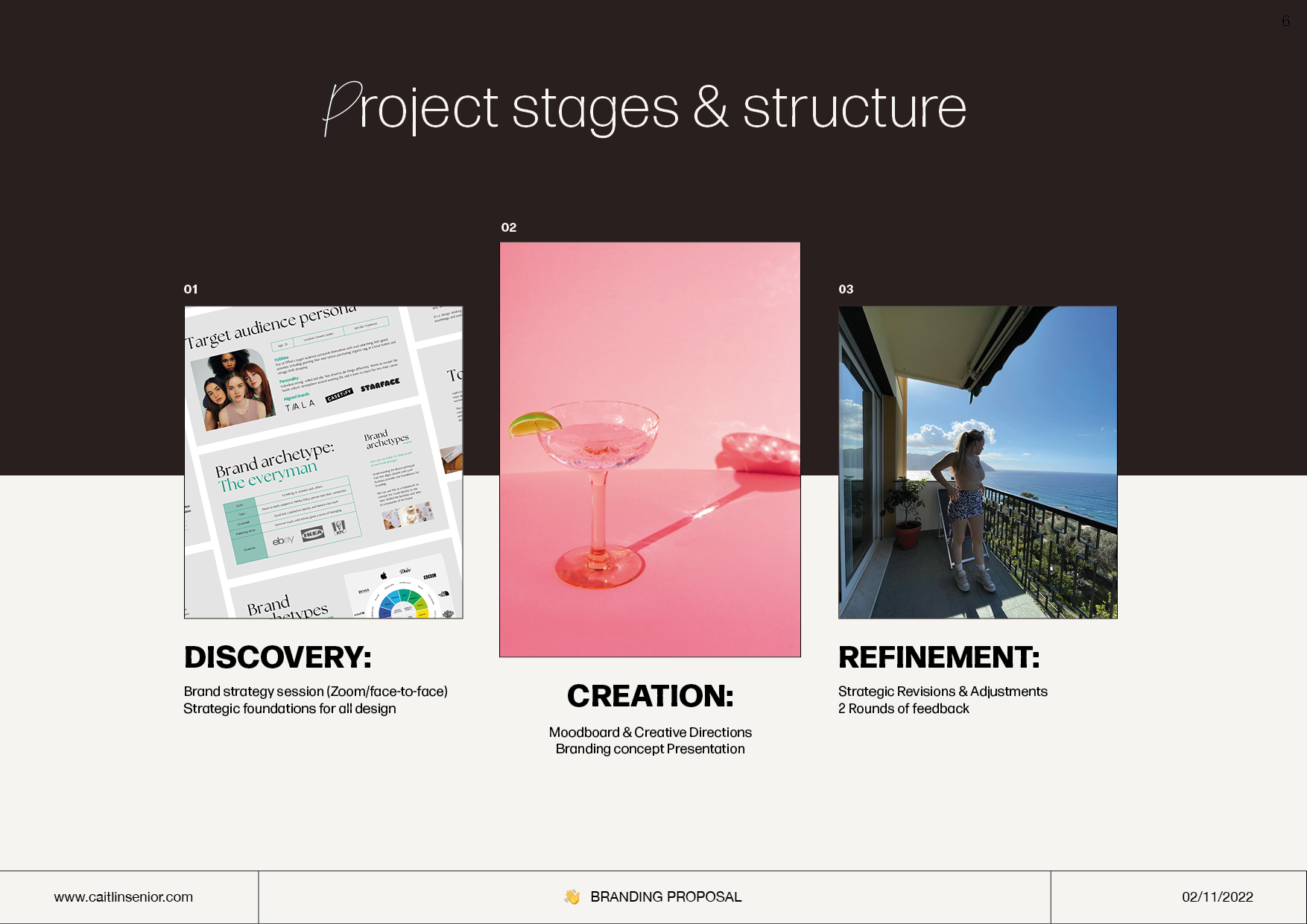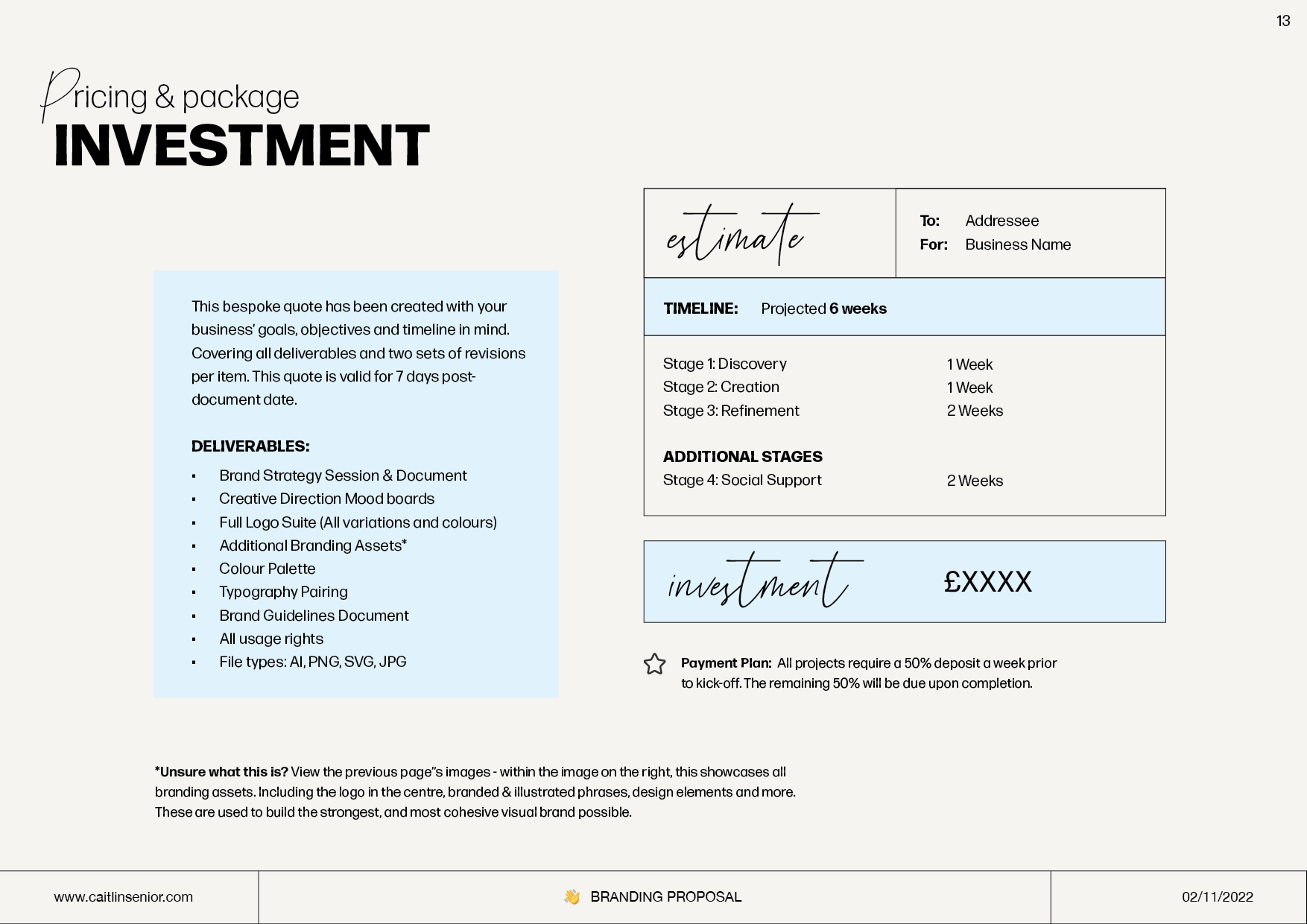Building a branding proposal: Behind the Scenes - Freelance Graphic Designer in Colchester
Introduction
Branding can feel like a complex process for any business owner. It's important for every branding agency or freelance graphic designer to build confidence and trust with in order to land projects. A branding proposal is the tool I use with my clients to share the branding process with them, as well as my vision and understanding of their business.
Your branding specialist will begin with reviewing your initial discussion to discover the main goals and objectives of your business and this project.
Once you have booked an initial discussion with your branding specialist, they will begin to build an idea of which deliverables, budget and timeline will align with your business best.
Your designer might ask questions like:
What are your goals for this project? What do you want to achieve from it? Are there any key milestones that need to be hit along the way? Are there any specific elements that are important for us not to forget about like social media accounts, competitors who are doing particularly great, branding styles you'd like me to consider etc?
Using this information, the designer will share their interpretation of a set number of goals, objectives and focus of the project within your businesses branding proposal.
Breakdown of stages: Key deliverables, Stage timing, project management systems and how you'll work with the designer.
Once you’re ready to move forward and start the project, there will be three main stages: Discovery, Creation and Refinement. Each stage has a different length of time associated with it, as well as different deliverables - but these will all be tracked using a project management system such as Notion, Asana or Trello.
At each stage, you will be working with the designer who will give you input on the process so you can trust everything is moving along smoothly.
Stage one: Discovery.
This stage begins with a brand strategy session, which is a 3 hour+ guided session followed by the creation of a 'Brand Strategy Document'. This session will dive deep into the 'why' behind your business, goals, objectives, tone of voice, competitors, brand archetypes and more.
The discovery stage can be completed remotely using Zoom (a video conferencing platform) or in person if you're based in Essex/Colchester/London - but the experience will be the same regardless of location.
Alternatively, if your budget doesn't allow for a brand strategy session I offer an alternative option: discovery will be limited to a questionnaire only; however if requested we are happy to do some initial consulting via phone call or email.
Stage two: Creation.
It's time to use all information and business goals shared in the discovery stage to build initial mood boards, creative direction and approval of general artistic alignment before the designer builds concepts.
Once approved, the designer will spend time building a full branding concept. Including mockups, colour palettes and many other visual elements. These branding concepts are shared in a presentation built to propose the vision your designer has for your business.
What is a mood board? A mood board is a collage made up of images and that reflects your brand’s style or personality.
What is creative direction? Creative Direction is what our design style will be for this project. The goal is creating consistency within each visual aspect so people recognise your business themselves throughout every channel - from social media posts to website headers without having them guess where they've seen these elements before.
Stage three: Logo & Brand Refinement
This is where you'll work with your designer to tweak and adjust elements of the proposed brand identity. Often, this will be limited to 2 rounds of revisions to ensure amendments are thoroughly considered and strategic.
Once you have the basic framework of your brand identity, it's time to get into the nitty gritty and start fine-tuning. You'll receive a final brand presentation ready to approve, and once you give the designer the 'thumbs-up', all assets will be ready for use.
The next stages may vary based on your decided deliverables. For example, website design, social media templates, packaging design or more.
Pricing and investment cost, including tiered options.
How much does branding cost?
Pricing and investment cost should be clearly explained in your business' proposal. This is an important part of the document, because it will help you to create a budget for your project. The investment cost will be based on the deliverables that are included in each tier, as well as any other costs associated with producing them.
Tiered options allow you receive different levels of branding depth at different price points; ensuring your business access to the services they need while keeping within their budget.
A good example of tiered pricing is when one package offers basic design services, while another package offers more extensive branding work and contains additional features like web design or print collateral development.
Pricing may also be higher if you're in a rush, which is called a 'rush rate'.
One style of investment page I use in my Branding Proposals.
Next steps - how the client can accept, adjust or decline proposal, payment method.
When you've finished reading the proposal, your designer will be ready to hear if you'd like to proceed with the project. If you are, let them know that they'll receive a contract covering terms and conditions.
This is a great opportunity to ask for any tweaks or adjustments within the proposal to ensure you're entirely happy with how the project will run.
Once you have the contract signed, and paid your project's deposit (often 50% of investment costs) your designer will share a start date and a timeline of when they you expect to see their brand live.
Next, the designer/design agency will share a link to jump on board to the project management software. Here, you'll see a full overview of project milestone dates and all tracked admin.
Branding proposals need to be detailed in order to help the client have confidence that you understand their needs, but retain interest and work to build confidence throughout.
The proposal should be detailed and thorough. It should include all the information needed to demonstrate that your designer understands your business' needs, as well as communicate their ability to deliver on those needs in an effective manner.
The key here is balancing detail with brevity with graphic design; too much information can bog down the text and make it difficult to read, while too little detail could leave client wondering how the process works.
Client Testimonial page - Branding Proposal
Conclusion
I hope that by taking an in-depth look at the different elements of a brand proposal, from the perspective of a local design specialist in Essex, you can feel confident about approaching a brand designer to build a proposal that works for your business. If you’re curious about how a designer would tackle branding or even a rebrand - reach out and I’ll build a bespoke document for you and your goals.












